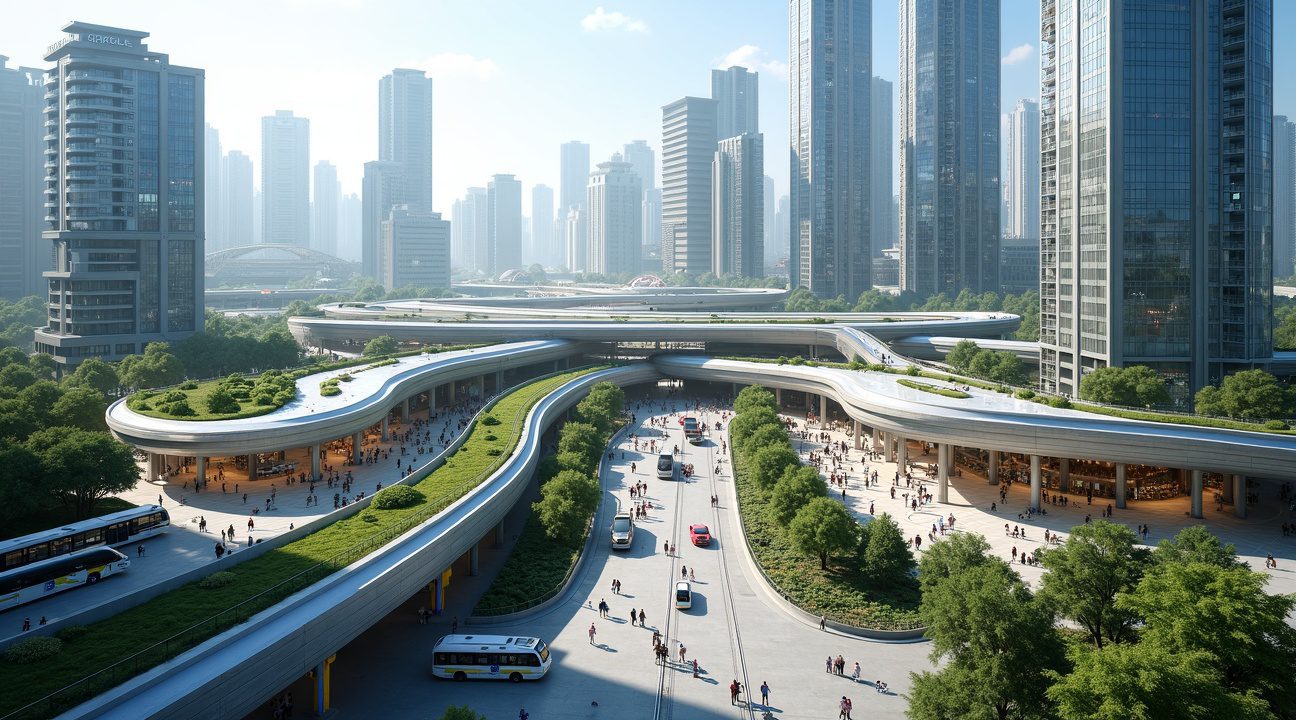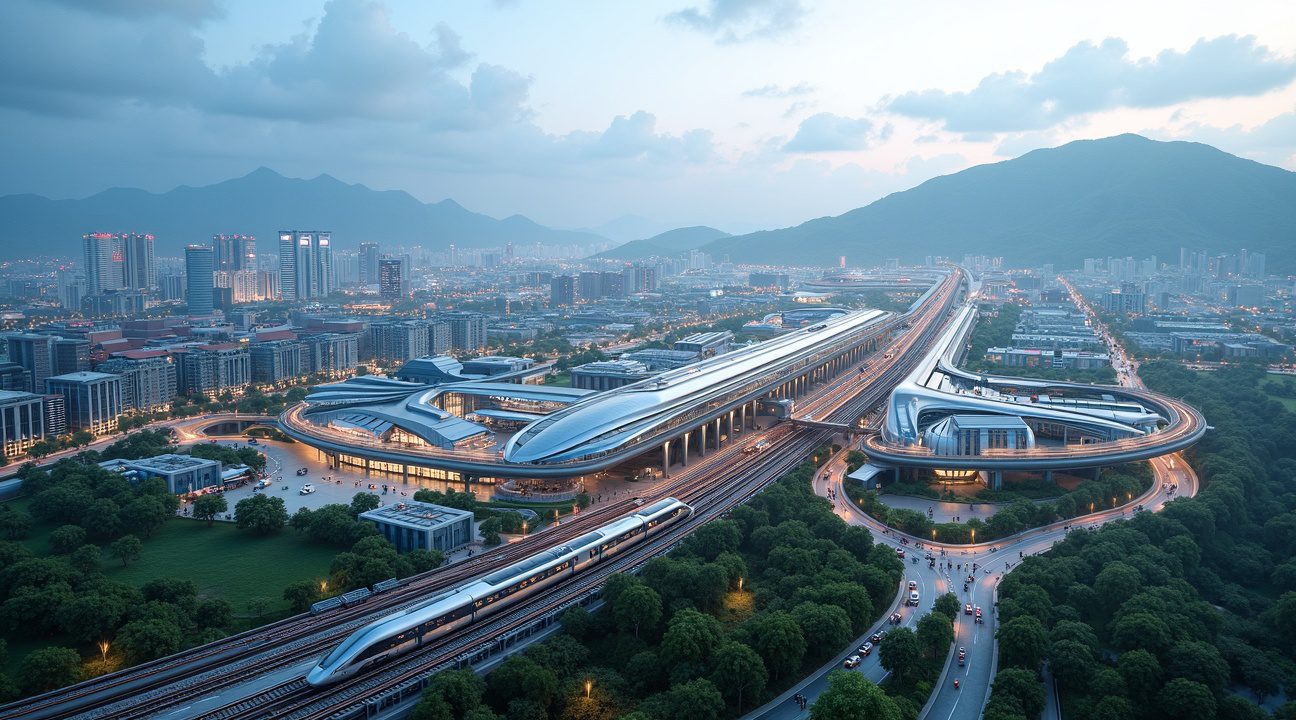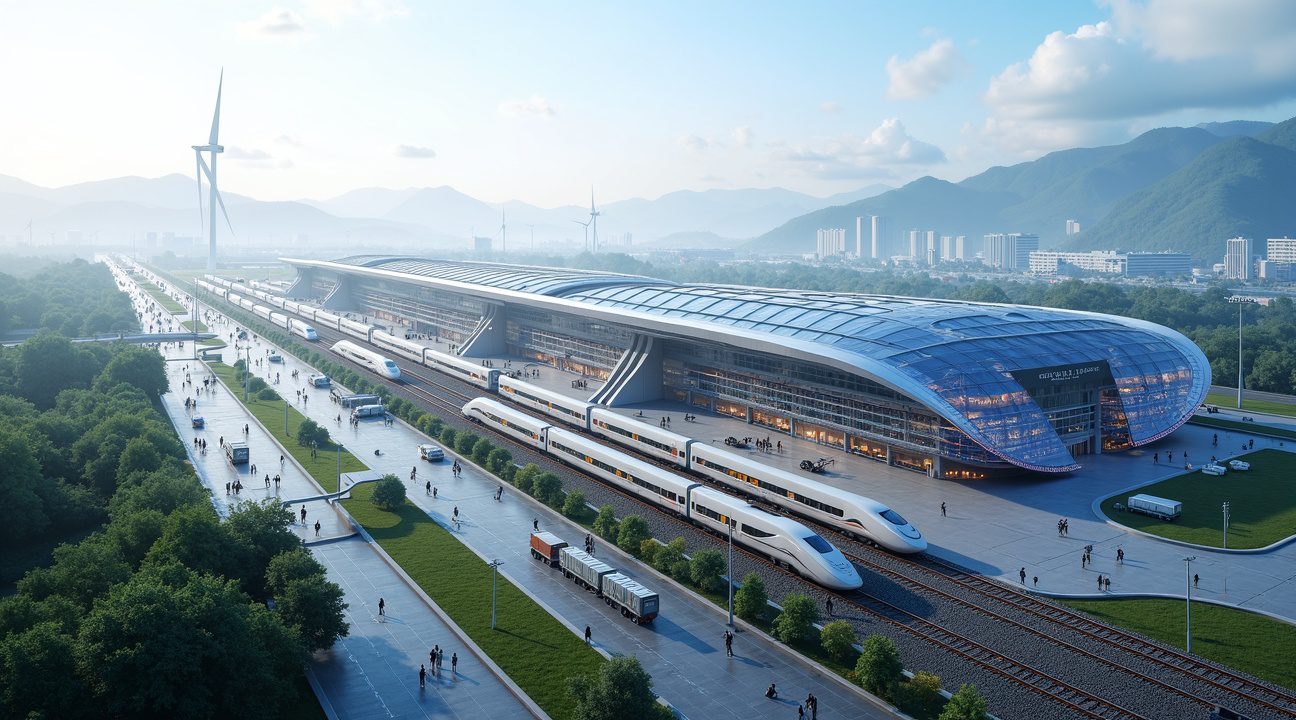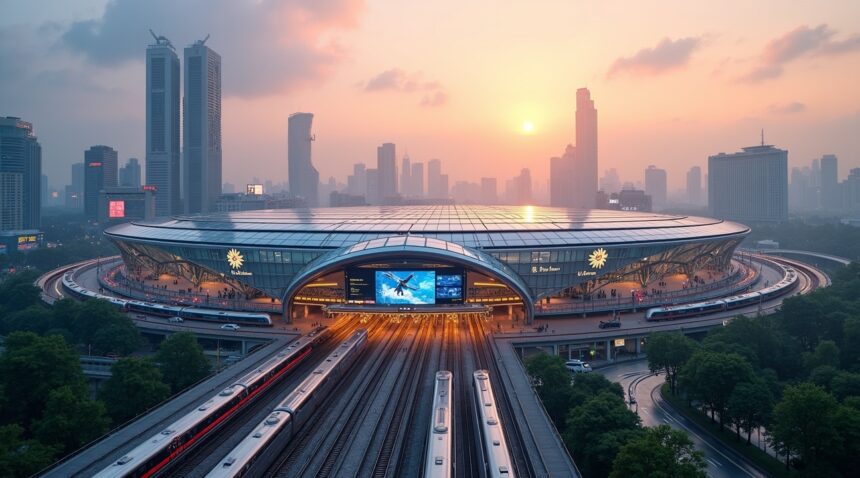China Unveils Chongqing East Railway Station: World’s Largest Railway Hub
China has officially opened Chongqing East Railway Station, establishing the world’s largest railway hub that spans 1.22 million square meters and sets new global benchmarks for transportation infrastructure.
This expansive facility serves as a keystone in China’s high-speed rail network. Connecting seven high-speed rail lines and integrating state-of-the-art smart technologies and sustainable design features, the station is expected to handle up to 60 million passengers annually.
Key Takeaways
- Record-breaking scale: The station spans 1.22 million square meters—equal to 170 football fields—making it six times larger than New York’s Grand Central Terminal, and nearly double the size of Guangzhou South Station in China.
- Unprecedented connectivity: The hub connects seven high-speed rail lines, two conventional railways, and four metro lines. This allows for zero-transfer travel throughout China, including one-hour journeys to major regional cities and six-hour trips to Beijing, Shanghai, and Guangzhou.
- Advanced smart technology: Chongqing East Railway Station incorporates laser-guided machinery, facial recognition-enabled intelligent gate systems, and real-time passenger flow management to accommodate up to 400,000 passengers daily during busy periods.
- Sustainable design achievement: The station was awarded China’s highest Three-Star Green Building Certification. It features solar panels, rainwater collection systems, energy-saving skylights, and eco-efficient heating and cooling infrastructure.
- Economic transformation catalyst: As a lynchpin of China’s Chengdu-Chongqing Twin City Economic Circle initiative, the station links western China’s 185,000 square kilometers to domestic and international trade routes, solidifying its role as a global infrastructure model.
Chongqing East Railway Station stands as a symbol of China’s ambition to redefine global standards for infrastructure, sustainability, and connectivity in the 21st century.
Breaking Records: The World’s Largest Railway Station Opens in China
China has officially opened Chongqing East Railway Station, setting a new global benchmark for railway infrastructure. This colossal transportation hub spans an impressive 1.22 to 1.23 million square meters, which equals roughly 170 football fields laid side by side.
The station’s scale becomes even more remarkable when compared to other major transportation centers worldwide. It is over six times larger than New York’s iconic Grand Central Terminal and nearly double the size of China’s own Guangzhou South Station. These comparisons highlight the ambitious scope of this project and China’s commitment to revolutionizing rail transport.
Architectural Marvel and Construction Achievement
The engineering behind Chongqing East Railway Station showcases cutting-edge construction capabilities. The eight-story structure is divided equally between above and below ground, with four levels on each side. This design maximizes both passenger flow efficiency and space utilization while maintaining structural integrity.
Key architectural features demonstrating the project’s scale include:
- The roof area covers 120,000 square meters and weighs an astounding 16,500 tons
- Advanced construction techniques incorporated automation throughout the building process
- 24/7 construction operations maintained continuous progress
- Specialized engineering solutions accommodated the massive weight distribution
The construction timeline represents another record-breaking achievement. From approval in May 2022 to opening in June 2025, the entire project was completed in just 38 months. This rapid development required an investment of $8 billion and coordination of thousands of workers and specialized equipment.
Advanced automation played a crucial role in meeting these aggressive deadlines. Construction teams utilized robotic systems for precision work while maintaining around-the-clock operations. This approach mirrors innovations seen in other transportation projects, similar to developments in autonomous vehicle technology, where automation enhances both speed and accuracy.
The station’s completion marks a significant milestone in global transportation infrastructure. Its capacity to handle millions of passengers annually will transform regional connectivity while setting new standards for future railway development projects worldwide. The combination of record-breaking size, innovative construction methods, and rapid completion timeline establishes Chongqing East Railway Station as a testament to modern engineering capabilities.
Revolutionary Hub Connecting China’s Vast Network
Chongqing East Railway Station stands as the centerpiece of China’s ambitious ‘Eight Vertical, Eight Horizontal’ high-speed rail grid, fundamentally transforming how millions traverse the country’s expansive landscape. This strategic positioning eliminates the traditional barriers between eastern and western regions that have historically complicated cross-country travel.
Unprecedented Connectivity and Capacity
The station’s design achieves something remarkable in modern transportation: true zero-transfer connectivity across multiple transport modes. Seven high-speed rail lines converge at this single point, joined by two conventional railways and four metro lines, creating seamless passenger flow that eliminates the frustration of lengthy transfers between different transport systems.
Operational capacity numbers reveal the station’s impressive scale. Engineers designed the facility to handle 16,000 passengers per hour during standard operations, with annual targets reaching 60 million travelers. During peak periods, the station can accommodate up to 400,000 passengers daily, numbers that rival some of the world’s busiest airports.
Travel times from Chongqing East demonstrate the station’s strategic value in China’s transportation network. Passengers can reach:
- Chengdu, Guiyang, and Wanzhou in approximately one hour
- Wuhan, Kunming, and Changsha in around three hours
- Beijing, Shanghai, and Guangzhou within six hours
The station’s location at the intersection of numerous rail lines creates a multiplier effect for China’s entire transportation infrastructure. Rather than forcing passengers to navigate complex transfers in multiple cities, travelers can now reach virtually any major destination across China through a single hub. This connectivity extends beyond passenger convenience, enabling more efficient freight movement and supporting economic development across previously underserved regions.
Smart technology integration supports these impressive operational capabilities. Automated systems manage passenger flow, while digital platforms provide real-time information about connections and delays. The station’s design anticipates future expansion, with infrastructure capable of supporting additional rail lines as China’s network continues growing.
For international observers studying large-scale transportation projects, Chongqing East represents a new model for hub design. The facility demonstrates how strategic planning can create transportation nodes that serve both immediate regional needs and long-term national connectivity goals. Its success will likely influence similar projects across Asia and beyond, as countries seek to replicate China’s approach to integrated transportation planning.
Smart Technology and Sustainable Design Transform Transportation
The Beijing Fengtai Railway Station showcases how cutting-edge automation revolutionizes passenger experience through laser-guided machinery and intelligent gate systems. These digital innovations work together to create a seamless flow management system that handles millions of travelers with unprecedented efficiency. The station’s comprehensive digital infrastructure provides real-time passenger management capabilities, allowing operators to monitor and adjust services instantly based on current demand patterns.
Advanced Automation Systems Enhance Passenger Flow
The facility employs sophisticated laser-guided machinery that operates with precision to manage baggage handling and platform operations. Smart gates equipped with facial recognition and digital ticketing systems process passengers quickly while maintaining security standards. Real-time data analytics help staff anticipate bottlenecks and redirect passenger traffic before congestion occurs, similar to how self-driving cars use sensors to optimize routes.
Three-Star Green Building Certification Drives Environmental Innovation
China’s highest environmental rating recognizes the station’s commitment to sustainable transportation infrastructure. Solar panels installed across the facility’s massive roof generate clean energy while rainwater collection systems capture and redistribute water for station operations. The shared heating and cooling systems optimize energy distribution throughout the complex, reducing waste and operational costs.
Energy-saving skylights flood the interior with natural light, minimizing reliance on artificial illumination during daylight hours. These sustainable design elements work together to significantly reduce the station’s carbon footprint while maintaining optimal passenger comfort. The combination of natural lighting and efficient HVAC systems creates an environment that feels open and welcoming rather than confined.
The station’s digital infrastructure transforms how transportation hubs operate at massive scale. Sensors throughout the facility monitor air quality, temperature, and passenger density to automatically adjust environmental controls. This smart building approach ensures optimal conditions while minimizing energy consumption across all operational areas.
These technological advances demonstrate how modern transportation infrastructure can balance efficiency with environmental responsibility. The integration of automation and sustainable design creates a model for future railway development that other countries are already studying and adapting for their own projects.
Station-City Integration Creates New Urban District
Chongqing East complex transforms the traditional railway station concept into something far more ambitious – a complete urban ecosystem that functions as both transportation hub and vibrant city district. This development represents a fundamental shift from viewing train stations as simple transit points to creating comprehensive destinations that serve multiple purposes throughout the day.
Transit-Oriented Development at Massive Scale
The complex operates as a transit-oriented development zone that seamlessly integrates transportation infrastructure with urban amenities.
- Hotels provide accommodation for travelers and business visitors
- Office spaces attract companies seeking prime connectivity
- Shopping centers cater to both passengers and local residents
This creates a continuous flow of activity that extends well beyond typical commuting hours.
Cultural venues within the complex add another layer of functionality, hosting events and exhibitions that draw visitors from across the region. This multi-use approach ensures the space remains active and economically viable throughout different times of day and seasons. The development creates its own economic ecosystem, generating employment opportunities and attracting investment that supports long-term growth.
Unified Design Philosophy Transforms Urban Planning
The integration follows a carefully coordinated design philosophy that treats passenger infrastructure and city amenities as interconnected elements rather than separate components. Architects and planners designed walkways, public spaces, and building connections to facilitate smooth transitions between transportation and urban functions. This approach eliminates the traditional barriers that typically separate railway facilities from surrounding neighborhoods.
Regional accessibility benefits significantly from this integrated model, as the development becomes a destination rather than just a waypoint. Business travelers can attend meetings without leaving the complex, while leisure visitors access shopping and cultural attractions directly from their arrival platform. The design supports multiple transportation modes, including autonomous vehicles and other emerging mobility solutions that complement traditional rail service.
Daily life for residents and workers in the surrounding area changes dramatically with this type of development. The concentration of services and amenities reduces the need for separate trips to different locations, supporting more sustainable travel patterns. Public spaces within the complex provide gathering areas that strengthen community connections while maintaining the efficiency of a major transportation hub.
The comprehensive urban planning approach addresses multiple infrastructure needs simultaneously, creating efficiencies that benefit both operators and users. Shared utilities, coordinated maintenance systems, and integrated security protocols reduce operational costs while improving service quality. This model demonstrates how large-scale infrastructure projects can support broader urban development goals beyond their primary transportation function.
Smart technology integration throughout the complex enables responsive management of both transportation and urban functions. Digital systems coordinate passenger flows with retail operations, adjust lighting and climate control based on occupancy patterns, and provide real-time information that helps visitors navigate the integrated environment. These technological capabilities support the complex operation of a development that serves millions of users annually while maintaining the efficiency expected from modern transportation infrastructure.
The success of this station-city integration model influences urban planning discussions worldwide, as cities seek ways to maximize the value of major infrastructure investments. Similar to how flying cars are transforming transportation, this integrated approach reshapes how planners think about the relationship between mobility infrastructure and urban development. The Chongqing East complex proves that railway stations can anchor comprehensive urban districts that serve diverse needs while maintaining their core transportation mission.

Anchoring Western China’s Economic Development
The massive railway hub stands as the cornerstone of China’s ambitious ‘Chengdu-Chongqing Twin City Economic Circle,’ a transformative project designed to unify 185,000 square kilometers of western China into a cohesive economic powerhouse. This initiative directly addresses the historical development disparity that has long separated China’s prosperous eastern coastal regions from its less developed western territories.
For decades, western China has struggled to match the economic dynamism of cities like Shanghai, Shenzhen, and Guangzhou. The new railway infrastructure changes this equation by dramatically improving connectivity and accessibility across the region. Strategic transportation links now enable businesses to establish operations in previously isolated areas, while workers can access employment opportunities that were once beyond reach.
Reshaping Regional Economic Corridors
The railway hub catalyzes fundamental changes in how economic activity flows through western China. I observe several key transformations emerging from this infrastructure investment:
- Manufacturing companies are relocating production facilities to take advantage of lower costs and improved logistics networks
- Service industries are expanding into secondary cities as transportation barriers dissolve
- Agricultural regions gain direct access to urban markets, boosting rural incomes and productivity
- Tourism sectors benefit from enhanced accessibility to previously remote destinations
- Technology companies establish satellite offices to tap into western China’s growing talent pool
These developments create a ripple effect that extends far beyond immediate transportation benefits. Cities that once operated in relative isolation now function as interconnected nodes in a larger economic network. The improved rail connections enable just-in-time manufacturing, reduce inventory costs, and facilitate the kind of supply chain integration that modern businesses require.
Local governments report increased foreign investment interest as international companies recognize the strategic value of positioning operations in well-connected western locations. The railway hub effectively reduces the time and cost penalties that previously made western China less attractive for business investment. Companies can now serve both domestic and international markets efficiently from inland locations, fundamentally altering the geography of Chinese economic development.
This infrastructure investment exemplifies how advanced transportation technology can reshape entire regions. The smart systems integrated into the railway network optimize traffic flow and reduce energy consumption, making sustainable economic growth possible on an unprecedented scale. Western China’s transformation from an economic periphery to a vital growth engine demonstrates the power of strategic infrastructure investment to rebalance national development patterns.

Strategic Role in China’s Global Trade Networks
Chongqing East Railway Station serves as a critical gateway within China’s ambitious Belt and Road Initiative, transforming how goods and people move between China’s interior and international markets. I’ve observed how this massive infrastructure project functions as more than a transportation hub—it’s a strategic logistics backbone that connects previously isolated inland regions to global trade corridors.
Connecting Interior China to International Trade Routes
The station’s strategic positioning enables direct connections that were previously impossible or inefficient. Freight and passenger services now flow seamlessly from China’s interior provinces westward through Xinjiang toward Central Asian markets, while simultaneously linking eastward to major coastal trading hubs including Shanghai and Fujian. This dual-direction connectivity eliminates traditional bottlenecks that forced cargo to take circuitous routes through multiple transfer points.
International businesses can now access China’s vast interior markets more efficiently than ever before. The station handles both high-speed passenger rail and dedicated freight corridors, allowing for synchronized movement of goods and business travelers. This integration reduces transport times significantly while cutting logistics costs for companies engaged in cross-border trade.
Setting Global Infrastructure Standards
Chongqing East establishes new benchmarks for mega infrastructure projects worldwide through its integration of speed, sustainability, and technological innovation. The facility incorporates smart transportation systems that optimize traffic flow and reduce energy consumption through automated scheduling and predictive maintenance algorithms.
Construction methodologies employed at the station are redefining how large-scale railway hubs can be built faster and more sustainably. Advanced materials and modular construction techniques reduce both environmental impact and construction timelines. These innovations serve as a template for similar projects globally, particularly in developing nations looking to modernize their transportation infrastructure rapidly.
The station’s design philosophy balances massive capacity requirements with environmental responsibility, incorporating renewable energy systems and efficient waste management protocols. Smart building technologies monitor and adjust energy usage in real time, while green spaces integrated throughout the complex help offset the carbon footprint of daily operations.
Future railway hub developments worldwide will likely adopt similar integrated approaches, combining high-capacity passenger and freight handling with advanced digital management systems. The success of Chongqing East demonstrates that large-scale infrastructure can simultaneously serve economic development goals while maintaining environmental sustainability standards.

Sources:
Wikipedia – Chongqing East Railway Station


